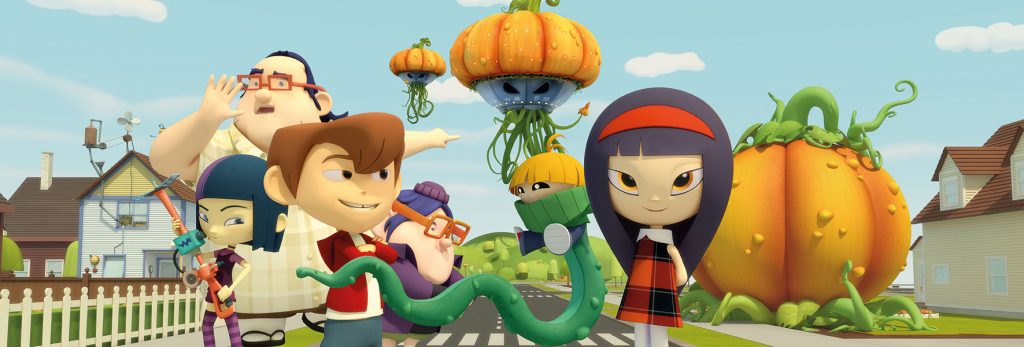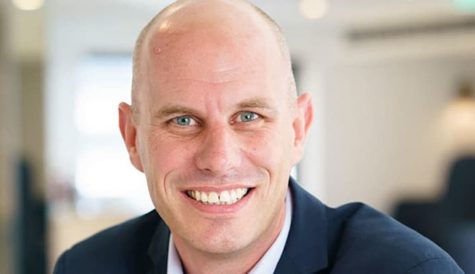
After more than 35 years of operation, TBI is closing its doors and our website will no longer be updated daily. Thank you for all of your support.
Spanimation: is Spain back on track?
 Thanks to the global success of series like Pocoyo, Lola & Virginia and Connie the Cow, Spain was widely expected to become a genuine powerhouse of European animation ten years ago. So what happened, where did it all go wrong and can the country return to past glories? Gary Smith reports
Thanks to the global success of series like Pocoyo, Lola & Virginia and Connie the Cow, Spain was widely expected to become a genuine powerhouse of European animation ten years ago. So what happened, where did it all go wrong and can the country return to past glories? Gary Smith reports
It may be some time ago, but we all remember just how scary 2008 was. The year that saw the unfolding sub-prime mortgage crisis pushing the global economy into meltdown, also, inevitably, sapped confidence in any and every industry relying on speculative investment, as well as in national economies that were over-exposed.
One of the most fragile and overexposed of those, with a predominantly tourism-based and agrarian economy, was that of Spain. The country was under such huge pressure from the collapse of a raft of large-scale construction projects that it was thought that it was heading for a major recession. Added to that, as is so often the case in times of hardship, central government reaction to what became known as ‘La Crisis’ was to cut all non-essential expenditure. The creative animation sector fitted that bill exactly.
Jorge Patiño, director of international sales and coproductions at Motion Pictures, picks up the story. “Government cuts affected the culture sector the most,” he recalls. “It wasn’t just that all subsidies stopped, but many of the grants that had already been approved and that had gone to production companies were clawed back, accompanied by a litany of dubious excuses.”
“Production companies either went bankrupt, or had to down-size significantly. Then most of the talent in Spain had to take jobs elsewhere, mainly the UK and France.
“However, in the last two years the situation has been partially reversed thanks to a wave of new digital players, alongside the unwavering efforts of TVE, TVC and Catalan government subsidies through ICEX [the Spanish foreign trade institute].”
 According to Carlos Biern (left), president of DIBOOS, the Spanish association of animators and special effects creators, the impact of La Crisis, followed by austerity measures across Europe, are mainly to blame. “The financial crisis in Europe, Brexit in the UK, and political problems in Catalonia have affected the economy,” he says. “Plus, the financial model for animation has changed completely in these last ten years.”
According to Carlos Biern (left), president of DIBOOS, the Spanish association of animators and special effects creators, the impact of La Crisis, followed by austerity measures across Europe, are mainly to blame. “The financial crisis in Europe, Brexit in the UK, and political problems in Catalonia have affected the economy,” he says. “Plus, the financial model for animation has changed completely in these last ten years.”
On top of all that, comments Peekaboo Animation CEO and executive producer Iván Agenjo, “advertising revenues and fees from TV channels started to drop, which exacerbated our problems, but it was the sudden cessation of access to financing that hit hardest”.
“The main challenge for the Spanish market is not the quality of our productions, or the fact that the market has changed quickly and fragmented, but a lack of financing tools, which leads to a lack of resources that impacts on our ability to adapt,” he adds.
Among the most notable of the failures was Zinkia Entertainment, the company behind Pocoyo, which fell into administration in 2013.
Despite their financing nightmares, Spain’s kids TV companies did their best. As Diego Ibáñez, international commercial director at Planeta Junior says: “Generally speaking, Spanish producers across the sector have done everything they could to accommodate new market realities. For example, our most recent coproduction came from a toy IP with a transmedia strategy that was developed around that.”
Institutional support is, however, way behind most neighbouring countries. “Spanish producers are obliged to go abroad to find investment for their projects,” says Ibáñez. “We are therefore at a disadvantage when compared to countries like France or the Benelux territories, where animation funds are more generous. However, the situation is getting better, and the current slate of Spanish animated productions is mostly built on new market business models. These include productions for the US’s biggest theatrical / VOD distributors, together with high-budget coproductions with China.”
Plus, at the end of 2017 and for the first time ever, the government approved productions of new TV shows funded by local private investors, he adds.
The popularity of locally produced cinema can be seen as an indicator of the underlying health of the sector. “The local box office for 2017 was once again topped by a Spanish animation production in the form of Ted Jones 2 [Tadeo Jones], which has so far generated close to E20 million [US$25 million] at the box office,” DIBOOS’ Biern says. “My guess is that the animation sector will generate well over E800 million in 2018, against E654 million in 2017, and that growth is largely down to Spanish animation producers adapting to new financing models. We are extremely proud of what Spanish companies are producing for the international market under ICEX’s Animation From Spain brand.”
Many in the sector share Biern’s view. “Over the last couple of years it has felt like we’re slowly getting our strength back,” says Vicente Martínez, business development manager at Animazing. “More companies seem to be coming up with new projects, and generally speaking the animation sector seems to be thriving again.
“I now see Spain as one of the main players for kids animation in Europe, and it’s fair to say that we are once again a reference point in terms of high-quality animation and innovative projects.”
Malaga-based Animazing is currently developing several new projects and animation projects. “Our strong suits are design and treating our projects as 360-degree brands and products,” says Martínez. “Our strategy is differentiation by quality. For that, our aim is to ally ourselves with the best possible partners for each project – so they can bring their own know-how and help us create a recipe for success.”
It is not for nothing that pre-2008 Spain was shaping up to be a major international force in animation – the country has a long history in the genre. “Spanish animation is already 100 years old, and some current companies are close to half a century old,” says Biern. “Things are changing for the better with the new incentives for film and TV production here in Spain really helping to transform the country into a production hotspot. These new incentives – introduced two years ago – include tax credits for Spanish productions and coproductions of up to 40%.
“Also, the government and local animation producers are starting to secure private and international investment, which will further strengthen our position in the international market.”
Biern is not, however, expecting an overnight transformation. “When you set up a new financing model, especially for the animation industry, it’s usually two or three years before you see the results, but looking to the opportunities of the next few years, you also have to bear in mind that Spain, alongside its talent and experience in the international market, is a bridge between Europe and South America,” he says. “A natural extension of our activities is through OTT and cable for the Lat Am audience.”
Motion Pictures’ Patiño believes there is still plenty of work to be done, however. “The volume of production is growing and the sector is in a much better situation than four or five years ago,” he says.
“However, access to grants and coproductions with national broadcasters is still very limited, and only accounts for a very small percentage of what we see on the international market.
“That said, a positive aspect of past problems is that new companies are diversifying their revenue streams by doing service work and working with foreign partners to get their own IP produced.”
Peekaboo’s Agenjo is also cautiously optimistic, but highlights a nagging legacy of La Crisis. “Our main problem now is to lure back the talented people who were forced to move away and work for other European producers,” he says. “What we need to do is rebuild a solid, stable industry that offers a continuous flow of work for our writers, illustrators, and animators.
“In terms of Peekaboo’s strategy, we prefer to remain a mid-sized production company with no in-house animation studio. We like to be small enough and flexible enough to adapt to market needs in order to focus on the core idea – concept development, scripting, graphic design, planning and financing – and be able to make strategic alliances with foreign producers, studios or partners to bring fresh new titles to the market.
“In an interconnected world you don’t need to know all the production steps: you need to know who the best partner for each step is, and convince people to get on board. That’s what we try to do.”
Agenjo now sees plenty to be positive about. “We’re working to establish a new funding system that will benefit animation, and the arrival of new digital platforms and new channels is also opening up new business opportunities,” he says. “The fact is, however, that the animation sector is now in a state of permanent mutation, so we have to adapt to living in an ever-changing reality, where new consumption habits are forcing us to be faster in order to feed the market. We will need to stay on top of trends and reinvent ourselves as often as is necessary.”
 Miguel Aldasoro of Anima Kitchent, which produces Cleo & Cuquín (left) for Discovery Kids Latin America and Mexico’s Televisa, agrees. “Animation in Spain has a much more promising future than it had five years ago, but another result of La Crisis is that even though the government now recognises the importance of the sector, they have no budget for traditional subsidies,” he says.
Miguel Aldasoro of Anima Kitchent, which produces Cleo & Cuquín (left) for Discovery Kids Latin America and Mexico’s Televisa, agrees. “Animation in Spain has a much more promising future than it had five years ago, but another result of La Crisis is that even though the government now recognises the importance of the sector, they have no budget for traditional subsidies,” he says.
“This is why Spain has initiated tax credits and tax incentives, plus is encouraging the private sector to invest in production through EIG [European economic interest groupings].
“Meanwhile, our plan is based around creating international entertainment brands for a global audience, each one with a strong digital component and based on a solid licensing and merchandising strategy.”
State of the animation nation
 Christophe Goldberger, founder of Barcelona-based Goldbee, represents the kids programmes from ZDF Enterprises in Spanish-speaking territories and Asia, including premium kids content such as School of Roars, Scream Street and Mako Mermaids. The exec, who has worked in Spain for 16 years, including a decade at Imira Entertainment, sees plenty of reasons to be optimistic.
Christophe Goldberger, founder of Barcelona-based Goldbee, represents the kids programmes from ZDF Enterprises in Spanish-speaking territories and Asia, including premium kids content such as School of Roars, Scream Street and Mako Mermaids. The exec, who has worked in Spain for 16 years, including a decade at Imira Entertainment, sees plenty of reasons to be optimistic.
“You have the long-established companies like Motion Pictures, already successful with Pumpkin Reports (pictured, top), currently developing MyaGO! with script-editor Sam Morrison [Peppa Pig, Ben and Holly]. Tomavision has just signed coproduction agreements with TVE and TV3, and with Red Kite for Bradley and Bee; and Dibulitoon Studio has been around for a while now, producing series and movies including Elcano and Teresa & Tim. Ilion Studio releases big budget animated movies such as Planet 51 and Mortadelo & Filemon and Planeta Junior is doing well with Gormiti.”
 “Alongside all of that there are up-and- coming production companies such as Peekaboo, currently in production on I, Elvis Riboldi, which has pre-sold to 120 countries; Teidees Ausiovisuals with Mölang and Under the Sofa; and Clay Animation’s Clay Kids,” says Goldberger.
“Alongside all of that there are up-and- coming production companies such as Peekaboo, currently in production on I, Elvis Riboldi, which has pre-sold to 120 countries; Teidees Ausiovisuals with Mölang and Under the Sofa; and Clay Animation’s Clay Kids,” says Goldberger.
“Animazing is currently developing a preschool show called Animukis, plus a hybrid project called GLOB!; and Ánima Kitchent now has a studio in the Canary Islands, where it is producing PINY and Cleo & Cuquin.”
The picture he explains is clear – Spain and its toon makers have bounced back.
Canary Islands flies the flag as production hub
Away from mainland Spain, new opportunities are arising as the country’s animation revival continues through new funding mechanisms and innovative financing pushes. Gran Canaria and Tenerife are currently becoming genuine animation and audiovisual hubs thanks to a tax credit incentive of up to €1 million (US$1.25 million) for production and a 35% tax rebate on foreign shoots’ spend, 20% higher than on the mainland.
Newly registered companies enjoy 4% corporate tax and no withholding taxes. They also benefit from tax deductions of up to 40% for audiovisual production. Canarian film productions are now eligible for 38-40% corporate tax credit up to a limit of €5.4 million, and foreign productions are offered a cash rebate of 35%, capped at €4.5 million.
“There are now nine companies with offices on the islands including Casa Animada, Salero Studios, Mondo TV, TomaVision, We Love Animation, 3Dobles and People Moving Pixels,” says Zulay Rodriguez, animation and video game consultant to the Tenerife Film Commission.
“We are doing everything possible to help them with logistics and more, including offering help and advice for people moving here and training locals in animation and audiovisual skills. However, it’s not just companies from Spain coming here. We already have several companies established here from elsewhere in Europe and we are expecting several more this year.”
The Spanish palette
Former NBCUniversal, Disney and KidsCo exec Paul Robinson took over as CEO of Madrid-based Imira Entertainment at the end of January. One of the British-born exec’s main objectives is to bring on local talent to replace the people who left during La Crisis.
“Currently there’s so little development money around that even sourcing the €10,000 (US$12,500) it takes to put together a bible is a challenge,” he says. “Given the rich and unique history of art in this country that’s a lot of talent going to waste and we intend to do something about it.”
Imira’s plan is to foster raw talent by working with young creators, then taking the best results to broadcasters. “Confidence is returning rapidly to the sector, plus we have telco Telefonica, whose originals series have been very successful and is now looking at producing content for kids, which could provide opportunities which are currently thin on the ground,” says Robinson.
“We want to show off Spanish culture and its fantastic visual heritage to the world, and to that end we’ll initially be working on three or four projects.”


